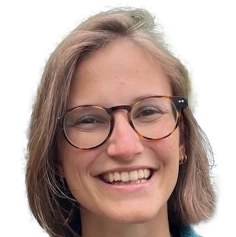Research Group Niki Kilbertus
Niki Kilbertus
is Assistant Professor of Ethics in Systems Design and Machine Learning at TU Munich.
He and his team investigate the interactions between machine learning algorithms and humans with a focus on ethical consequences and trustworthiness. They currently study identification and estimation of causal effects from observational data in automated decision-making and dynamic environments.
Team members @MCML
PhD Students

Birgit Kühbacher
→ Group Niki Kilbertus
Ethics in Systems Design and Machine Learning
Recent News @MCML
Publications @MCML
2025
[28]
Y. E. Şahin • N. Kilbertus • S. Becker
Predicting symbolic ODEs from multiple trajectories.
ML4PS @NeurIPS 2025 - Workshop on Machine Learning and the Physical Sciences at the 39th Conference on Neural Information Processing Systems. San Diego, CA, USA, Nov 30-Dec 07, 2025. PDF
Predicting symbolic ODEs from multiple trajectories.
ML4PS @NeurIPS 2025 - Workshop on Machine Learning and the Physical Sciences at the 39th Conference on Neural Information Processing Systems. San Diego, CA, USA, Nov 30-Dec 07, 2025. PDF
[27]
M. Bahrami • A. Tejada-Lapuerta • S. Becker • F. S. Hashemi G. • F. J. Theis
scConcept: Contrastive pretraining for technology-agnostic single-cell representations beyond reconstruction.
Preprint (Oct. 2025). DOI
scConcept: Contrastive pretraining for technology-agnostic single-cell representations beyond reconstruction.
Preprint (Oct. 2025). DOI
[26]
Z. Li • N. Kilbertus
Graph Distance Based on Cause-Effect Estimands with Latents.
Preprint (Oct. 2025). arXiv
Graph Distance Based on Cause-Effect Estimands with Latents.
Preprint (Oct. 2025). arXiv
[25]

J. Schweisthal • D. Frauen • M. Schröder • K. Heß • N. Kilbertus • S. Feuerriegel
Learning Representations of Instruments for Partial Identification of Treatment Effects.
ICML 2025 - 42nd International Conference on Machine Learning. Vancouver, Canada, Jul 13-19, 2025. URL
Learning Representations of Instruments for Partial Identification of Treatment Effects.
ICML 2025 - 42nd International Conference on Machine Learning. Vancouver, Canada, Jul 13-19, 2025. URL
[24]

J. Zausinger • L. Pennig • A. Kozina • S. Sdahl • J. Sikora • A. Dendorfer • T. Kuznetsov • M. Hagog • N. Wiedemann • K. Chlodny • V. Limbach • A. Ketteler • T. Prein • V. M. Singh • M. M. Danziger • J. Born
Regress, Don't Guess -- A Regression-like Loss on Number Tokens for Language Models.
ICML 2025 - 42nd International Conference on Machine Learning. Vancouver, Canada, Jul 13-19, 2025. URL GitHub
Regress, Don't Guess -- A Regression-like Loss on Number Tokens for Language Models.
ICML 2025 - 42nd International Conference on Machine Learning. Vancouver, Canada, Jul 13-19, 2025. URL GitHub
[23]
C. Casolo • S. Becker • N. Kilbertus
Identifiability Challenges in Sparse Linear Ordinary Differential Equations.
Preprint (Jun. 2025). arXiv
Identifiability Challenges in Sparse Linear Ordinary Differential Equations.
Preprint (Jun. 2025). arXiv
[22]
G. Manten • C. Casolo • S. W. Mogensen • N. Kilbertus
An Asymmetric Independence Model for Causal Discovery on Path Spaces.
CLeaR 2025 - 4th Conference on Causal Learning and Reasoning. Lausanne, Switzerland, May 07-09, 2025. URL
An Asymmetric Independence Model for Causal Discovery on Path Spaces.
CLeaR 2025 - 4th Conference on Causal Learning and Reasoning. Lausanne, Switzerland, May 07-09, 2025. URL
[21]

G. Manten • C. Casolo • E. Ferrucci • S. Mogensen • C. Salvi • N. Kilbertus
Signature Kernel Conditional Independence Tests in Causal Discovery for Stochastic Processes.
ICLR 2025 - 13th International Conference on Learning Representations. Singapore, Apr 24-28, 2025. URL
Signature Kernel Conditional Independence Tests in Causal Discovery for Stochastic Processes.
ICLR 2025 - 13th International Conference on Learning Representations. Singapore, Apr 24-28, 2025. URL
[20]

Z. Li • S. S. Cranganore • N. Youngblut • N. Kilbertus
Whole Genome Transformer for Gene Interaction Effects in Microbiome Habitat Specificity.
AAAI 2025 - 39th Conference on Artificial Intelligence. Philadelphia, PA, USA, Feb 25-Mar 04, 2025. DOI
Whole Genome Transformer for Gene Interaction Effects in Microbiome Habitat Specificity.
AAAI 2025 - 39th Conference on Artificial Intelligence. Philadelphia, PA, USA, Feb 25-Mar 04, 2025. DOI
[19]

T. Willem • V. A. Shitov • M. D. Luecken • N. Kilbertus • S. Bauer • M. Piraud • A. Buyx • F. J. Theis
Biases in machine-learning models of human single-cell data.
Nature Cell Biology. Feb. 2025. DOI
Biases in machine-learning models of human single-cell data.
Nature Cell Biology. Feb. 2025. DOI
[18]

E. Ailer • C. L. Müller • N. Kilbertus
Instrumental variable estimation for compositional treatments.
Scientific Reports 15.5158. Feb. 2025. DOI
Instrumental variable estimation for compositional treatments.
Scientific Reports 15.5158. Feb. 2025. DOI
[17]
K. Padh • Z. Li • C. Casolo • N. Kilbertus
Your Assumed DAG is Wrong and Here's How To Deal With It.
Preprint (Feb. 2025). arXiv
Your Assumed DAG is Wrong and Here's How To Deal With It.
Preprint (Feb. 2025). arXiv
2024
[16]
B. Kühbacher • F. Iglesias-Suarez • N. Kilbertus • V. Eyring
Towards Physically Consistent Deep Learning For Climate Model Parameterizations.
ICMLA 2024 - 23rd IEEE International Conference on Machine Learning and Applications. Miami, FL, USA, Dec 18-20, 2024. DOI
Towards Physically Consistent Deep Learning For Climate Model Parameterizations.
ICMLA 2024 - 23rd IEEE International Conference on Machine Learning and Applications. Miami, FL, USA, Dec 18-20, 2024. DOI
[15]
A. White • A. Büttner • M. Gelbrecht • N. Kilbertus • F. Hellmann • N. Boers
Projected Neural Differential Equations for Power Grid Modeling with Constraints.
D3S3 @NeurIPS 2024 - Workshop on Data-driven and Differentiable Simulations, Surrogates, and Solvers at the 38th Conference on Neural Information Processing Systems. Vancouver, Canada, Dec 10-15, 2024. URL
Projected Neural Differential Equations for Power Grid Modeling with Constraints.
D3S3 @NeurIPS 2024 - Workshop on Data-driven and Differentiable Simulations, Surrogates, and Solvers at the 38th Conference on Neural Information Processing Systems. Vancouver, Canada, Dec 10-15, 2024. URL
[14]

E. Ailer • N. Dern • J. Hartford • N. Kilbertus
Targeted Sequential Indirect Experiment Design.
NeurIPS 2024 - 38th Conference on Neural Information Processing Systems. Vancouver, Canada, Dec 10-15, 2024. URL
Targeted Sequential Indirect Experiment Design.
NeurIPS 2024 - 38th Conference on Neural Information Processing Systems. Vancouver, Canada, Dec 10-15, 2024. URL
[13]
T. Schwarz • C. Casolo • N. Kilbertus
Uncertainty-Aware Optimal Treatment Selection for Clinical Time Series.
Preprint (Oct. 2024). arXiv
Uncertainty-Aware Optimal Treatment Selection for Clinical Time Series.
Preprint (Oct. 2024). arXiv
[12]
A. White • A. Büttner • M. Gelbrecht • V. Duruisseaux • N. Kilbertus • F. Hellmann • N. Boers
Projected Neural Differential Equations for Learning Constrained Dynamics.
Preprint (Oct. 2024). arXiv
Projected Neural Differential Equations for Learning Constrained Dynamics.
Preprint (Oct. 2024). arXiv
[11]

A. Szałata • K. Hrovatin • S. Becker • A. Tejada-Lapuerta • H. Cui • B. Wang • F. J. Theis
Transformers in single-cell omics: a review and new perspectives.
Nature Methods 21. Aug. 2024. DOI
Transformers in single-cell omics: a review and new perspectives.
Nature Methods 21. Aug. 2024. DOI
[10]
F. Quinzan • C. Casolo • K. Muandet • Y. Luo • N. Kilbertus
Learning Counterfactually Invariant Predictors.
Transactions on Machine Learning Research. Jul. 2024. URL
Learning Counterfactually Invariant Predictors.
Transactions on Machine Learning Research. Jul. 2024. URL
[9]
I. Obadic • A. Levering • L. Pennig • D. Oliveira • D. Marcos • X. Zhu
Contrastive Pretraining for Visual Concept Explanations of Socioeconomic Outcomes.
Workshop @CVPR 2024 - Workshop at the IEEE/CVF Conference on Computer Vision and Pattern Recognition. Seattle, WA, USA, Jun 17-21, 2024. DOI
Contrastive Pretraining for Visual Concept Explanations of Socioeconomic Outcomes.
Workshop @CVPR 2024 - Workshop at the IEEE/CVF Conference on Computer Vision and Pattern Recognition. Seattle, WA, USA, Jun 17-21, 2024. DOI
[8]

S. d'Ascoli • S. Becker • P. Schwaller • A. Mathis • N. Kilbertus
ODEFormer: Symbolic Regression of Dynamical Systems with Transformers.
ICLR 2024 - 12th International Conference on Learning Representations. Vienna, Austria, May 07-11, 2024. URL GitHub
ODEFormer: Symbolic Regression of Dynamical Systems with Transformers.
ICLR 2024 - 12th International Conference on Learning Representations. Vienna, Austria, May 07-11, 2024. URL GitHub
[7]

L. Eyring • D. Klein • T. Uscidda • G. Palla • N. Kilbertus • Z. Akata • F. J. Theis
Unbalancedness in Neural Monge Maps Improves Unpaired Domain Translation.
ICLR 2024 - 12th International Conference on Learning Representations. Vienna, Austria, May 07-11, 2024. URL
Unbalancedness in Neural Monge Maps Improves Unpaired Domain Translation.
ICLR 2024 - 12th International Conference on Learning Representations. Vienna, Austria, May 07-11, 2024. URL
[6]
Z. Li • S. S. Cranganore • N. Youngblut • N. Kilbertus
Whole Genome Transformers for Gene Interaction Effects in Microbiome Habitat Prediction.
MLGenX @ICLR 2024 - Workshop Machine Learning for Genomics Explorations at the 12th International Conference on Learning Representations. Vienna, Austria, May 07-11, 2024. URL
Whole Genome Transformers for Gene Interaction Effects in Microbiome Habitat Prediction.
MLGenX @ICLR 2024 - Workshop Machine Learning for Genomics Explorations at the 12th International Conference on Learning Representations. Vienna, Austria, May 07-11, 2024. URL
[5]

S. Feuerriegel • D. Frauen • V. Melnychuk • J. Schweisthal • K. Heß • A. Curth • S. Bauer • N. Kilbertus • I. S. Kohane • M. van der Schaar
Causal machine learning for predicting treatment outcomes.
Nature Medicine 30. Apr. 2024. DOI
Causal machine learning for predicting treatment outcomes.
Nature Medicine 30. Apr. 2024. DOI
2023
[4]
E. Thelisson • G. Mika • Q. Schneiter • K. Padh • H. Verma
Toward Responsible AI Use: Considerations for Sustainability Impact Assessment.
Preprint (Dec. 2023). arXiv
Toward Responsible AI Use: Considerations for Sustainability Impact Assessment.
Preprint (Dec. 2023). arXiv
2022
[3]

H. Aliee • T. Richter • M. Solonin • I. Ibarra • F. J. Theis • N. Kilbertus
Sparsity in Continuous-Depth Neural Networks.
NeurIPS 2022 - 36th Conference on Neural Information Processing Systems. New Orleans, LA, USA, Nov 28-Dec 09, 2022. URL
Sparsity in Continuous-Depth Neural Networks.
NeurIPS 2022 - 36th Conference on Neural Information Processing Systems. New Orleans, LA, USA, Nov 28-Dec 09, 2022. URL
[2]

L. Hetzel • S. Boehm • N. Kilbertus • S. Günnemann • M. Lotfollahi • F. J. Theis
Predicting Cellular Responses to Novel Drug Perturbations at a Single-Cell Resolution.
NeurIPS 2022 - 36th Conference on Neural Information Processing Systems. New Orleans, LA, USA, Nov 28-Dec 09, 2022. URL
Predicting Cellular Responses to Novel Drug Perturbations at a Single-Cell Resolution.
NeurIPS 2022 - 36th Conference on Neural Information Processing Systems. New Orleans, LA, USA, Nov 28-Dec 09, 2022. URL
[1]
L. Hetzel • S. Boehm • N. Kilbertus • S. Günnemann • M. Lotfollahi • F. J. Theis
Predicting single-cell perturbation responses for unseen drugs.
MLDD @ICML 2022 - Workshop on Machine Learning for Drug Discovery at the 39th International Conference on Machine Learning. Baltimore, MD, USA, Jul 17-23, 2022. URL
Predicting single-cell perturbation responses for unseen drugs.
MLDD @ICML 2022 - Workshop on Machine Learning for Drug Discovery at the 39th International Conference on Machine Learning. Baltimore, MD, USA, Jul 17-23, 2022. URL
©all images: LMU | TUM








